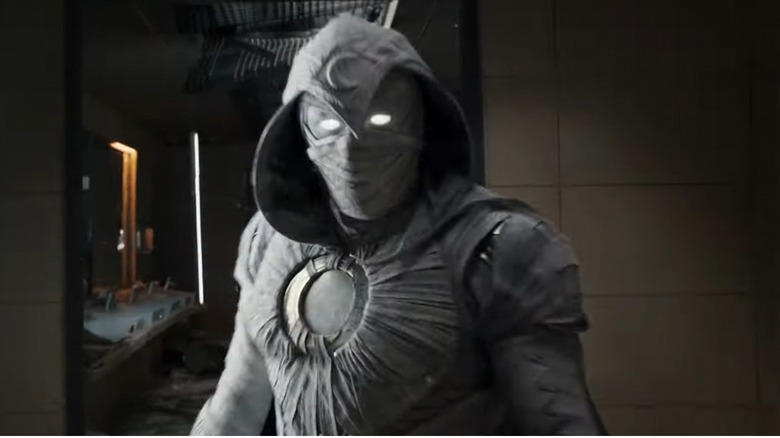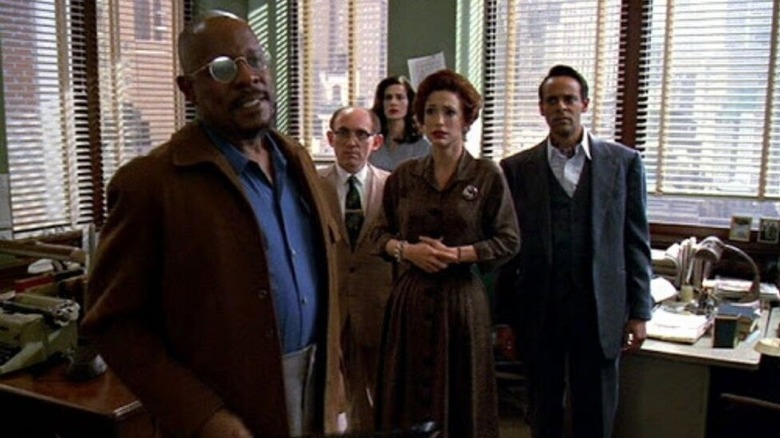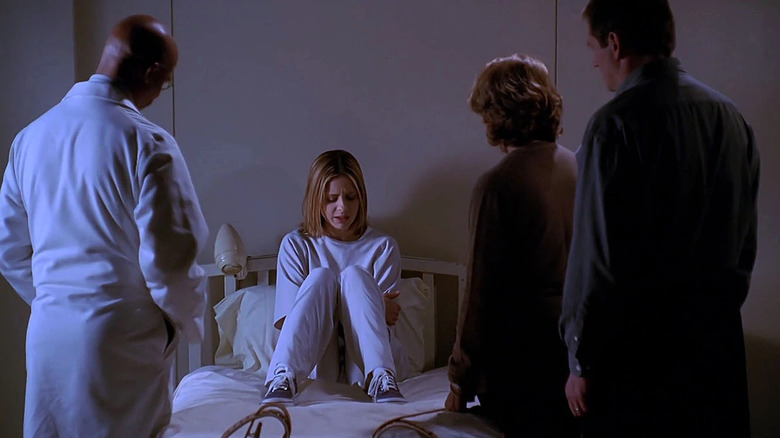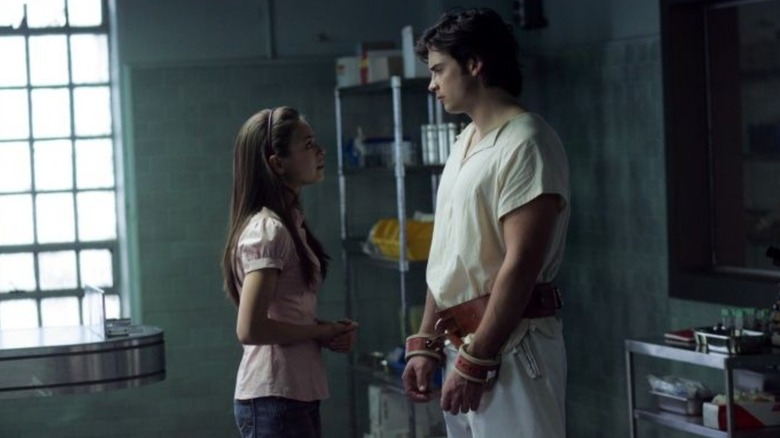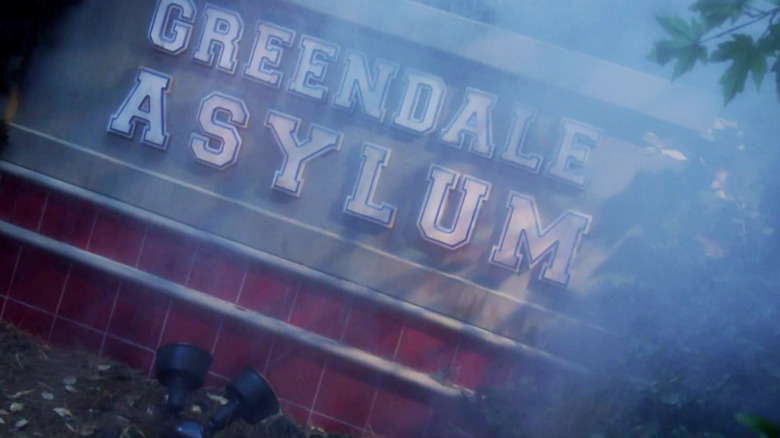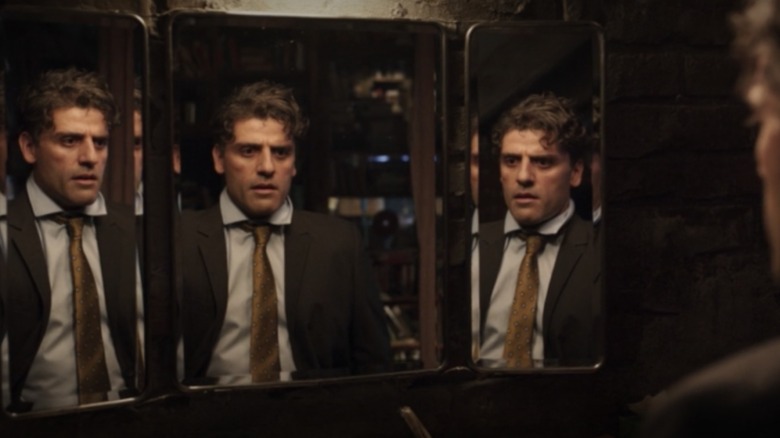Moon Knight Episode 4's Big Twist Is A Classic TV Trope
Warning: Major spoilers for the most recent episode of "Moon Knight."
The latest episode of "Moon Knight," "The Tomb," threw us for a loop. Could it be that Marc Spector (Oscar Isaac) is simply a delusional mental patient who's too obsessed with the B-movie adventures of archaeologist Steven Grant? That he's cast his fellow patients as supporting characters in his fantasy and his doctor as the villainous Arthur Harrow (Ethan Hawke)? Is nothing we thought true? Yeah, right.
This premise — the hero wakes up in an asylum, surrounded by familiar faces telling them the events of the show have been a delusional fantasy — is a common one in sci-fi and fantasy shows. It makes sense that "Moon Knight" is where Marvel finally explores this trope, given the titular hero's dissociative identity disorder has been a lynchpin for the show. But where has this plot been used before? Let's run down a few classic examples and examine why it's a trope that genre TV shows love to use again and again.
Deep Space Nine – 'Far Beyond The Stars'
A classic example of this type of story is "Star Trek: Deep Space Nine" episode "Far Beyond The Stars." In the throes of the Dominion war, Captain Ben Sisko (Avery Brooks) is feeling down, especially after a friend dies in combat. The captain then enters a very different world — 1950s New York City, to be precise. Sci-fi writer Benny Russell (also played by Brooks) has written a story about a familiar-looking space station captained by a Black man named Sisko. However, Benny will have to fight tooth and nail with the institutionalized prejudice of the time to see his story published.
The usual cast of "DS9" are assigned different roles throughout the episode, mostly as Benny's co-workers at "Incredible Tales" magazine. Notably, the actors who played the show's alien characters are out of make-up and out of character; Michael Dorn (Worf) is Willie Nelson, Benny's laid-back baseball player friend who couldn't be more different from the stuffy Klingon who Dorn usually plays. Armin Shimerman (Quark) is Herbert Rossoff; far from a traditionalist (i.e. capitalist) Ferengi bar owner, Rossoff is the resident lefty at "Incredible Tales."
Some of the characters' New York counterparts aren't so different; Marc Alaimo (Dukat) and Jeffrey Combs (Weyoun) play a pair of cops who harass Russell and shoot his young friend Jimmy (Cirroc Lofton, usual role Jake Sisko) dead. Most interestingly, Rene Auberjonois (Odo) is Douglas Pabst, the magazine's editor-in-chief. The story takes Odo's role as head of station security and flips it on its head; Pabst is a small-c conservative who refuses to rock the boat by publishing a story with a Black lead.
"Far Beyond The Stars" is a self-reflexive episode. Kay Eaton (Nana Visitor, aka Major Kira Nerys), who writes under the gender-ambiguous pen name KC Hunter, has to be a reference to "Trek" writer DC Fontana. "Star Trek" has always been socially conscious, but in the utopian future of the Federation, racial prejudice has been eradicated. The framing device of Benny's story "Deep Space Nine" finally gives the show a chance to examine what a big deal the series being led by a Black captain is.
Benny Russell's world is telegraphed to be hallucinations from the beginning; the show all but states that the Bajoran prophets are trying to revitalize the faith of Sisko, their Emissary. Before Russell's world takes over the episode completely, Dr. Bashir (Alexander Siddig) notes Sisko's brain patterns resemble previous times he's experienced visions from the Prophets. Throughout the episode, a preacher played by Brock Peters (regular role Sisko's father Joseph) encourages Benny to follow the path of Prophets.
However, the episode ultimately chooses not to give easy answers about which reality is the real one. In a failed bid to get "Deep Space Nine" published, Benny rewrites the ending to make the story the dream of a contemporary Black man. This gives the framing device a level of circular meta-textuality. Before Sisko reawakens on the real Deep Space Nine, the preacher tells Russell, "You are the dreamer and the dream." One part of the meaning is clear — he's both Ben Sisko and Benny Russell. However, this doesn't answer which one is the dreamer and which one is the dream. Sisko is left uncertain himself by the end; the last shot of the episode is him looking at his reflection and seeing Benny staring back.
Benny Russell would return in the season 7 episode "Shadows and Symbols," where he's been committed to an asylum after his mental break at the end of "Far Beyond The Stars." Showrunner Ira Steven Behr even had an audacious pitch for the series finale involving Russell:
"The final episode would end up with Benny Russell on Stage 17 at Paramount, wandering around the sound stages, realizing that this whole construct, this whole series that we had done for seven years, was just in Benny's head. That is how I wanted to end the series."
Behr's ending would've definitely made Russell into the dreamer and Sisko into the dream. However, in what was probably for the best, the show didn't go through with this. "DS9" series finale "What You Leave Behind" lacks any ambiguity about what is and isn't reality in the "Trek" universe.
Buffy the Vampire Slayer – 'Normal Again'
A line-of-sight gag in "Far Beyond The Stars" indicates that Rossoff had a rejected story pitch about a cheerleader who fights vampires. This was an inside joke about "Buffy The Vampire Slayer," where Shimerman played hard-nosed Principal Snyder. Fittingly enough, "Buffy" would have its own "is everything a hallucination?" episode in its sixth Season: "Normal Again."
"Buffy" ran for five seasons on The WB, with the final episode "The Gift" featuring the series' heroine (Sarah Michelle Gellar) making the ultimate sacrifice. However, the series was swiftly revived by UPN for two additional seasons. Season 6 opens with Buffy resurrected by her witchy best friend Willow (Alyson Hannigan), in a season that ultimately proved to be the darkest and grimmest of "Buffy." A DVD behind-the-scenes feature even declared that in season 6, "Life is the Big Bad." So, late in the season, when Buffy learns her life might be a fantasy, she can't shrug it off.
In "Normal Again," a scuffle with a demon leaves Buffy poisoned and suffering hallucinations that she's an asylum patient. According to her doctor, Sunnydale is nothing more than an elaborate illusion she created to sustain her heroism fantasies. Unusually, the show's supporting cast doesn't show up in the "real" world. They're instead painted as constructs of the fantasy that Buffy must slay to regain her grip on reality. The only recognizable face in the asylum scenes is Buffy's late mother Joyce (Kristine Sutherland); a familiar face who anchors the fantasy scenes for both Buffy and the viewer.
As she becomes more seduced by her visions of the hospital, Buffy asks aloud, "What's more real, a sick girl in an institution or some kind of supergirl chosen to fight demons and save the world?" This question illustrates why it's specifically genre shows which use this type of story; it only works when the show's premise is far out enough that it could only be a hallucination in real life. In doing so, the show plays on the audience's own suspension of disbelief. The episode also puts an ironic twist on the escapism that the audience enjoys; Buffy's life slaying vampires is fun for us, but it's gotten so hard for her she prefers to believe it's not real. The more realistic world becomes Buffy's escapism from the "real" supernatural one — or does it?
The last scene of "Normal Again" is in the asylum, where Buffy's doctor tells her despairing parents that their daughter has permanently succumbed to her illness. The obvious conclusion is that the asylum was indeed the real world and Sunnydale the hallucination. Showrunner Marti Noxon disputes this; in "Slayers and Vampires: The Complete Uncensored, Unauthorized, Oral History of Buffy the Vampire Slayer and Angel," (by Mark Altman and Edward Gross), she says:
"It was a fake out; we were having some fun with the audience. I don't want to denigrate what the whole show has meant. If Buffy's not empowered then what are we saying? If Buffy's crazy, then there is no girl power; it's all fantasy. And really the whole show stands for the opposite of that, which is that it isn't just a fantasy. There should be girls that can kick ass. So I'd be really sad if we made that statement at the end. That's why it's just somewhere in the middle saying "Wouldn't this be funny if ...?" or "Wouldn't this be sad or tragic if...?" In my feeling, and I believe in Joss' as well that's not the reality of the show. It was just a tease and a trick."
While Noxon has her interpretation, it's just that, an interpretation. By ending the way it does, "Normal Again" puts the viewer in Buffy's shoes and forces them to choose which reality they want to believe is true.
Smallville – Labyrinth
What is "Smallville" if not "Superboy" + "Buffy"? Naturally, "Smallville" had its own "Superhero in the asylum" episode: "Labyrinth." It's a by-the-numbers rendition; Clark Kent (Tom Welling) awakens in a mental hospital. One Dr. Hudson (Matthew Walker) tells him that his Kryptonian origin, superpowers, etc., are all a delusion, created to cope with the death of his birth parents in the Smallville meteor shower.
A twist is that the supporting cast's lives are mostly the same, but reconfigured around the hallucination. Martha Kent (Annette O'Toole) and Lana Lang (Kristin Kreuk) are still a loving mother and girlfriend, respectively, which means they want Clark to get "better." Chloe Sullivan (Allison Mack) is still Clark's confidante, and thus is the one who sustains his delusions about superpowers. The biggest deviation concerns Lex Luthor (Michael Rosenbaum). In the series' pilot, Clark and Lex became friends after the latter crashed into the former; the super-resistant Clark fished an unconscious Lex out of his drowned car, kicking off a doomed friendship. In the "Labyrinth" reality, Clark having no superpowers means Lex came away from the accident paralyzed and with a chip on his shoulder.
"Labyrinth" lacks the introspection of "Far Beyond The Stars" or "Normal Again" and is nowhere near as ambiguous. By "Smallville" season 6, the monsters of the week had changed from "Meteor Freaks" (Smallville residents granted superpowers by Kryptonite exposure) to Phantom Zone escapees. Dr. Hudson turns out to be a Phantom trying to take over Clark's body; our hero defeats him with some help from the Martian Manhunter (Phil Morris).
"Labyrinth" is ultimately a version of a story that's been done before, and done better, elsewhere, but with some DC Comics wallpaper stapled on. That's really "Smallville" in a nutshell, isn't it?
Community – Curriculum Unavailable
As a sitcom, "Community" might seem the odd one out of these shows. However, that presupposes "Community" is a normal sitcom. Instead, the show is better described as not just a parody of TV, but often of genre itself. Season 3 episode "Curriculum Unavailable" is mostly a parody of clip shows, but it throws in an "it's all a hallucination" sequence towards the end.
In the previous episode, "Course Listing Unavailable," the study group was expelled from Greendale Community college. Abed (Danny Pudi) takes this poorly and begins trespassing on school property; to avoid him being charged, the group takes him to a psychiatrist. Dr. Heidi (John Hodgman) eventually drops the bombshell on the group: There is no Greendale Community College.
The group was institutionalized together and the past three seasons were a shared hallucination. As Heidi explains this, the episode then shows clips of the group in "Greendale Asylum" together. It takes three steps from Heidi's office for Jeff (Joel McHale) to realize the holes in this. For one, Annie (Alison Brie) wore a Greendale College backpack to the session. Heidi caves, revealing he was hired by Ben Chang (Ken Jeong) to lie to the group and deter them from returning to Greendale.
That the deception is so quickly unveiled speaks to the inherent ludicrousness of this premise; "it was all just a dream" is the most hackneyed twist in storytelling for a reason. It also reflects how no series which has done this plot has ever committed to it. So, why do shows keep using it?
Why is this a trope?
This trope provides a potent metaphor for television itself. After all, the worlds that the characters of "Deep Space Nine," "Buffy," "Smallville," "Community," and "Moon Knight" inhabit aren't real. "Everything was a delusion, you're really in an asylum" puts the character in the place of the viewer, forced to deal with everything they've invested in being fiction.
The premise also strikes the right mix of shock and safety that's essential to television. Done well, an episode with this premise can instill a kernel of doubt in the viewer's mind, but only for a moment. For one, the show must go on; revealing everything about the show's story is false would undermine it to the point it couldn't be continued. It would also be a challenge, if not an insult to the audience; you wasted your time getting invested in something that was never real to begin with. As such, there's a safety hidden in the suspense; of course everything will turn out to be "real" by the episode's end.
After all, no show which has done this premise has pulled the trigger all the way; the indefinite teasing of "Deep Space Nine" and "Buffy" come the closest, but still don't go all the way. Considering its place within the larger MCU, I doubt that "Moon Knight" will be the one to break this rule.
